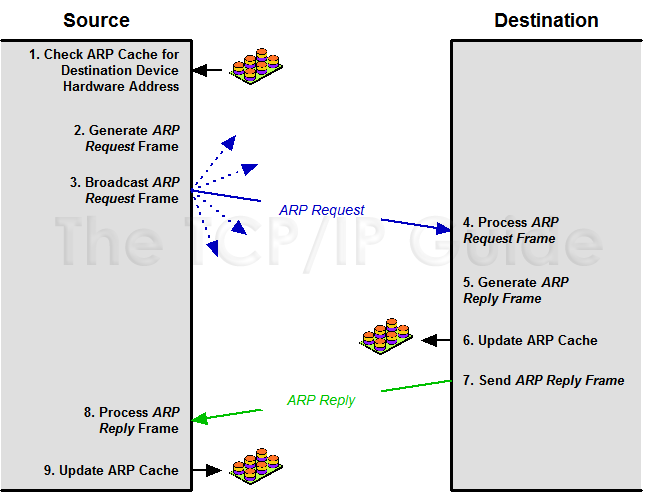# ARP - Address Resolution Protocol
ARP is used to map an IP address to a MAC address on a local network (LAN).
Remember:
- IP address identifies a device logically (Network layer / Layer 3).
- MAC address identifies a device physically on the Ethernet or Wi-Fi network (Data Link layer / Layer 2).
ARP is the bridge between Layer 3 and Layer 2.
TIP
ARP is essential for local delivery of IP packets. Without it, devices wouldn’t know which MAC address to send Ethernet frames to.
# How it works
- Step 1: ARP Request
- The sender broadcasts a request on the LAN:
“Who has IP 192.168.1.10? Tell 192.168.1.1”
- The sender broadcasts a request on the LAN:
- Step 2: ARP Reply
- The device with IP 192.168.1.10 responds directly:
“IP 192.168.1.10 is at MAC aa:bb:cc:dd:ee:ff”
- The device with IP 192.168.1.10 responds directly:
- Step 3: Cache
- Sender stores this mapping in its ARP cache to avoid repeating the process.

- ARP enables a computer to find the MAC address of the computer that is associated with an IP address
- In order for devices to communicate, the sending devices need both IP addresses & the MAC addresses of the destination devices.
- When they try to communicate with devices whose IP addreses they know, they must determine the MAC addresses
- ARP table stores in RAM

Destination local
Find Device or IP Address using MAC Address (opens new window)
# Commands
List ARP table:
arp -a # window
arp -n # linux / mac
ip neigh # linux / mac
Watch ARP traffic
sudo tcpdump -n -i eth0 arp
Check for duplicate IPs:
ping -b
arping # utilities (for diagnostics).
# ARP spoofing / ARP poisoning
# How NetCut-like tools work
- Core technique: most NetCut-style tools perform ARP spoofing / ARP poisoning (sometimes combined with MAC spoofing or fake DHCP replies).
- They send forged ARP replies on the LAN that tell your victims:
“The gateway IP (or some other IP) is at attacker‑MAC”. - Victim machines update their ARP cache and start sending traffic to the attacker’s MAC (man‑in‑the‑middle) or drop it — effectively cutting their network access.
- They send forged ARP replies on the LAN that tell your victims:
- Why it works: Ethernet LANs trust ARP replies and switches forward frames based on MAC addresses. On flat L2 segments with no protections, forged ARP is very effective.
- NetCut variants: some just flood incorrect ARP responses (to break connectivity), others actively intercept and forward traffic (to sniff / modify).
# How to prevent and mitigate (by environment)
Home / Small office (recommended steps)
- Use a modern router with DHCP & ARP protections
- Enable any “IP/MAC binding” or “static DHCP” features so trusted devices keep assigned IPs.
- Use separate guest Wi‑Fi for visitors — that isolates guest clients from LAN devices.
- Keep firmware updated on router/AP/switch (security fixes).
- Use HTTPS / TLS / VPN for sensitive traffic — even if ARP spoofing happens you still have encryption.
- Disable WPS and use strong Wi‑Fi passwords to prevent unauthorized clients joining the LAN.
- Use endpoint protection on PCs (OS firewall, anti-malware) and disable unnecessary network file sharing on untrusted networks.
- If your SOHO switch supports it: enable port security (limit MAC per port).
# Tools & logging
- arpwatch — logs IP↔MAC changes on a segment and alerts on suspicious changes.
- IDS/IPS (Snort/Suricata) — rules to detect ARP spoofing/gratuitous ARP anomalies.
- Switch logs / SNMP — monitor MAC flapping, MAC moves, and port security events; feed to SIEM.